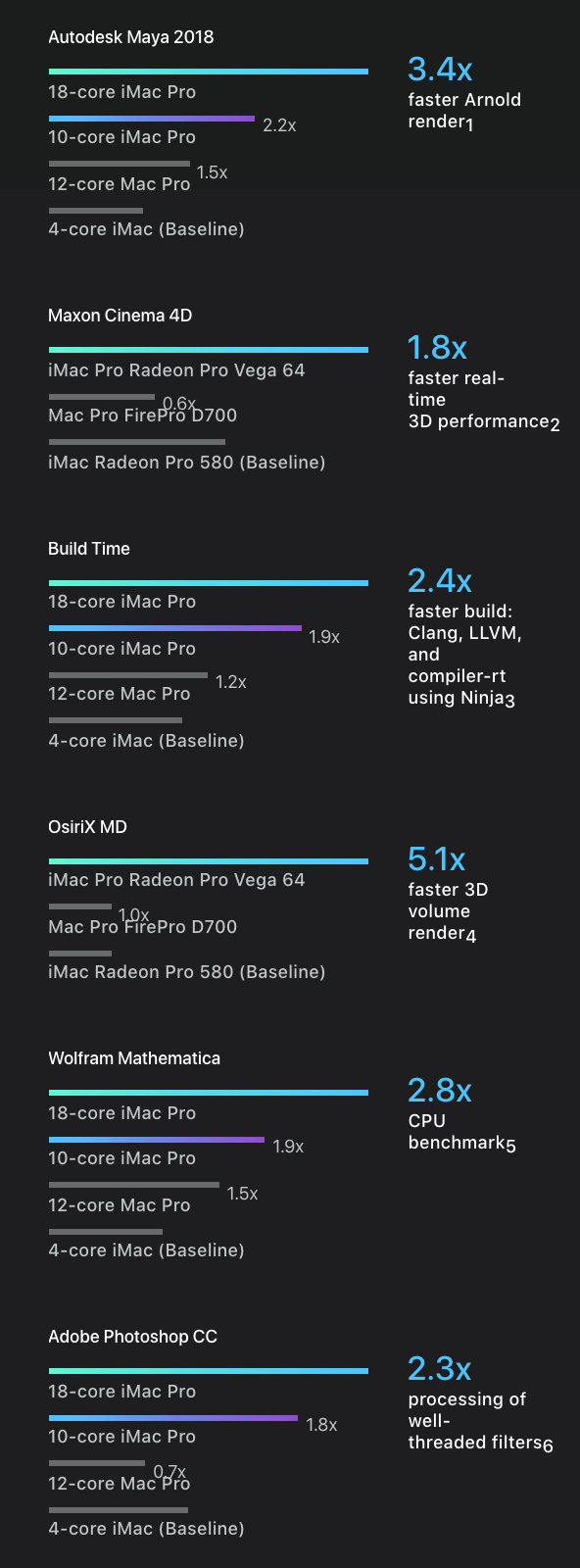
Sans their mobile offerings, the Apple Pro line of computers is characterized by workstation-grade hardware including Xeon processors and ECC memory. Traditionally, workstation-level performance was only in available in the Mac Pro, but the all-new iMac Pro is breaking the mold bring a new level of performance to the all-in-one line.
Starting at $4,999, which is exponentially more expensive than the MacBook Pro and the Mac Pro, the iMac Pro offers a 3.2 GHz 8-core Intel Xeon W processor, 32 GB of DDR4 ECC RAM, 1 TB SSD, Radeon Pro Vega 56 with 8 GB HBM2 Memory, 10 GB Ethernet, 4 Thunderbolt 3 ports, and the class-leading 27 Inch 5K Retina display.
In typical Apple fashion, everything is upgradable before purchase, but is not upgraded post-purchase. A fully specced out iMac Pro with an 18-core Xeon, 128 GB ECC RAM, 4 TB SSD, and 16 GB Radeon Pro Vega will run you just shy of $13,200, so considering the impressive numbers on the spec sheet and the price tag, who is this machine geared toward?

[REWIND: DJI Inspire 2 & Zenmuse X7 Review | A Pro Cinema Tool That Makes A Studio Out Of A Single User]

It warrants pointing out here, however, that the benefits of the two-part Xeon and ECC RAM will be lost on photographers versus the more ubiquitous Core i7. Clock-for-clock, Xeon processors are typically slower at most tasks task than the Core alternative. Instead of speed, Xeons rely on precision across their multitude of cores, which is why in the case of the iMac Pro the clock speed drops as more cores are added.
The second part of the equation, Error Checking and Correction (ECC) RAM detects and corrects most common data corruption before it occurs, eliminating the cause of many system crashes and translating to more stable overall performance. Unless you know your application requires ECC memory, future buyers are just throwing money at the hype. So, to answer my question who is the iMac Pro geared toward? The iMac Pro is geared toward ‘creative professionals,’ whatever that means.

The Skylake-based 8-plus-core Xeon W processor and DDR4 ECC memory will benefit those professionals who deal with real-time 3D rendering, High Frame Rate VR, complex simulations/analysis, machine learning, and faster code compiling – i.e., architects, video game designers, developers, scientists, doctors, et cetera.


Even though there are members of the photographic community that are chomping at the bit to get the latest and ‘most powerful Mac ever’, for photographers and videographers, the machine will be as overkill as buying a McLaren P1 to go on grocery runs.
The new iMac Pro will not speed up photography workflows and it won’t make Lightroom run any faster. Apple knows this, which is why in the majority of their marketing material and initial keynote photography was mentioned at the bottom and in the briefest way possible (see below).

That being said, if Adobe could properly implement programs that took advantage of multiple cores and the huge bandwidth the Radeon Pro Vega offers, the machine would be beneficial, otherwise the more affordable 27-inch iMac will suit photographers needs just fine.




Get Connected!